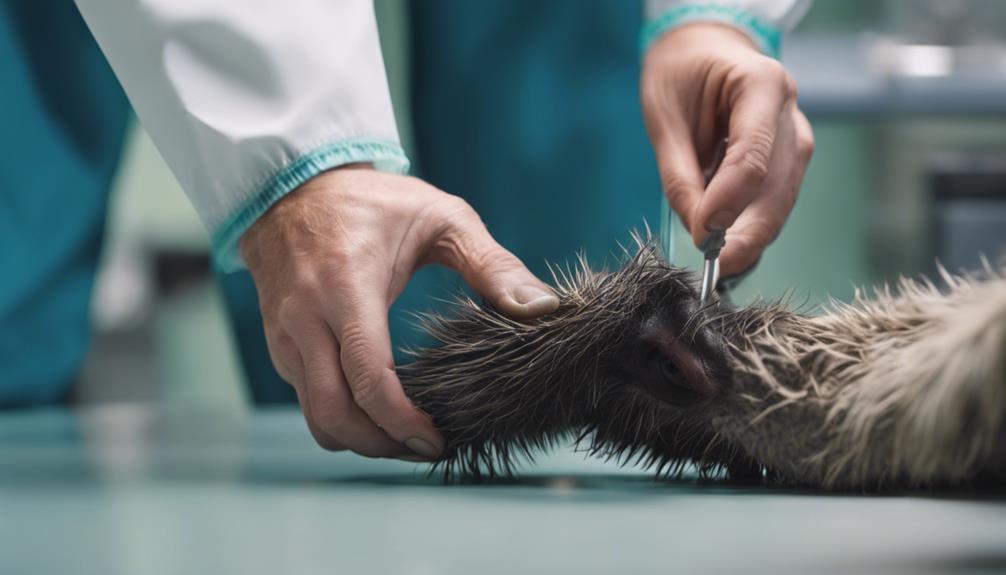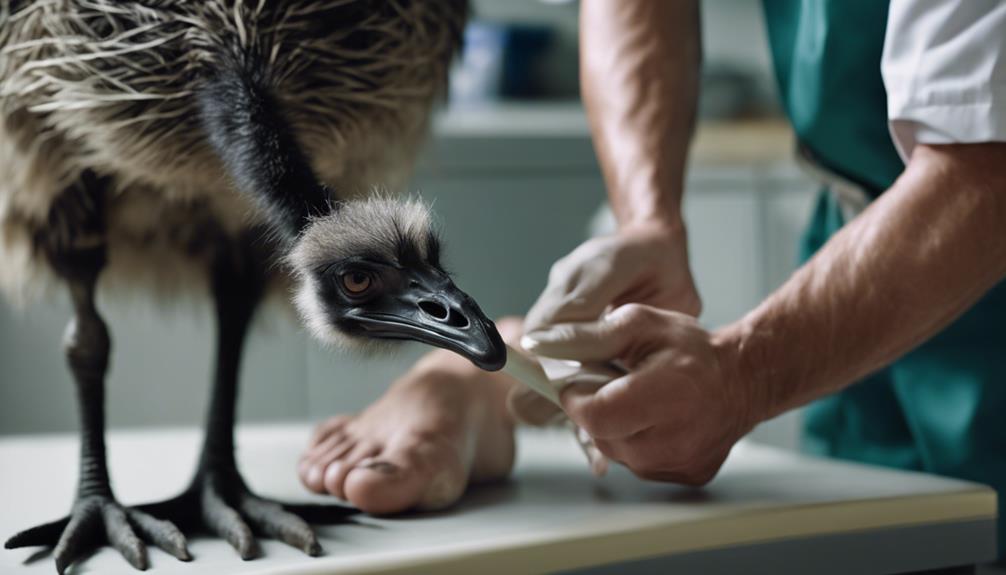
As you ponder the intricacies of emu foot health, have you considered the key factors that play a role in maintaining the well-being of these fascinating creatures? Understanding the unique challenges that emus face concerning their feet is just the beginning. With their distinct foot anatomy and potential health issues, exploring effective preventative measures and proper care techniques becomes paramount. Discovering how to promote optimal foot health in emus can lead to a deeper appreciation for these majestic birds and ensure their longevity in captivity or the wild.
Key Takeaways
- Regular nail trimming prevents overgrowth and maintains proper weight distribution.
- Clean living environment and balanced diet prevent bumblefoot bacterial infections.
- Provide varied terrain for foot exercise and mental stimulation in their roaming environment.
- Foraging opportunities for vegetation and insects keep emus active and engaged.
- Regular health checks, including foot inspections, help detect issues early for optimal foot health.
Emu Foot Anatomy

Explore the intricate anatomy of an emu foot to understand its unique structure and functionality. Emus possess a remarkable foot structure designed for power and agility. The emu foot consists of two main parts: the lower leg and the foot itself. The lower leg is powerful and supports the bird's weight, while the foot is a marvel of adaptation.
At the heart of the emu foot are three long toes, each ending in a sharp claw. These toes provide balance and stability, crucial for the bird's swift movements. The inner toe is the shortest and helps prevent the emu from sinking into softer ground. In contrast, the outer toes are longer and aid in propulsion. This asymmetrical arrangement is a key feature of the emu's unique biomechanics.
Furthermore, the emu foot is covered in tough, scaly skin, offering protection from rough terrain and potential predators. Understanding the anatomy of an emu foot sheds light on the bird's impressive capabilities and survival strategies.
Common Foot Issues
The intricate anatomy of an emu foot not only showcases its unique structure and functionality but also lays the foundation to understand the common foot issues that can potentially affect these fascinating birds.
One common foot issue that emus may face is bumblefoot, a condition caused by bacterial infections that can lead to painful swellings on the foot.
Another issue is footpad dermatitis, where the skin on the foot becomes inflamed and irritated, often due to unsanitary living conditions or excessive moisture.
Emus can also suffer from overgrown nails, which, if not properly trimmed, can cause discomfort and affect their ability to walk and run effectively.
Additionally, arthritis can affect emu foot health, leading to joint pain and stiffness, especially in older birds.
Understanding these common foot issues is crucial for maintaining the overall health and well-being of emus, ensuring they can thrive in their environments.
Signs of Foot Problems

Identifying signs of foot problems in emus involves closely monitoring their behavior and physical condition for any indications of discomfort or abnormalities. When observing your emus, watch out for subtle changes that may signal underlying foot issues. Here are some key signs to look out for:
| Signs of Foot Problems | Description | Action Required |
|---|---|---|
| Limping | Uneven gait or favoring a foot | Inspect foot closely |
| Swelling | Enlargement of the foot | Consult a vet |
| Redness | Inflammation or irritation | Provide soft bedding |
| Pecking at feet | Excessive self-grooming | Check for sharp objects |
| Reluctance to stand | Avoiding putting weight on a foot | Limit movement |
Importance of Nail Trimming
Regular nail trimming is crucial for maintaining the overall foot health of emus, ensuring they can move comfortably and avoid potential complications. Neglecting nail trimming can lead to overgrown nails, which may cause discomfort, affect the emu's gait, and potentially lead to injuries or infections. Here are three key reasons why nail trimming is essential for emu foot health:
- Prevents Overgrown Nails: Regular nail trimming prevents the nails from becoming excessively long, which can interfere with the emu's natural movement and cause discomfort.
- Maintains Proper Weight Distribution: Keeping the nails at an appropriate length helps the emu distribute its weight evenly across the foot, reducing the risk of strain or imbalance.
- Reduces Risk of Injuries: Trimmed nails lessen the chances of the emu getting caught on objects or surfaces, minimizing the risk of injuries such as torn nails or broken toes.
Preventing Bumblefoot

To maintain optimal foot health in emus, proactive measures should be taken to prevent the development of bumblefoot. Bumblefoot, a common condition in birds like emus, occurs when bacteria enter small cuts or abrasions on the foot, leading to infection and inflammation.
To prevent this debilitating ailment, ensure that the emus' living environment is clean and free of sharp objects that could cause injuries to their feet. Regularly inspect their feet for any signs of redness, swelling, or sores, as early detection is key to preventing bumblefoot from progressing.
Additionally, provide emus with proper flooring that isn't too abrasive or hard, as this can contribute to foot injuries. Maintaining a balanced diet rich in essential nutrients and ensuring that emus have enough space to move around freely can also aid in preventing bumblefoot.
Proper Roaming Environment
Maintaining an appropriately spacious and stimulating roaming environment is crucial for ensuring the overall well-being and foot health of emus. To provide the best environment for your emus, follow these three key guidelines:
- Adequate Space: Emus are large, active birds that require ample space to move around freely. Ensure that the roaming area allows for running, stretching, and natural behaviors like dust bathing. A lack of space can lead to stress and potential foot problems.
- Varied Terrain: Emus benefit from a diverse terrain that includes grassy areas, sandy patches, and even some rocky surfaces. This variety helps exercise their feet and promotes healthy circulation. Avoid keeping them on hard, flat surfaces for extended periods.
- Environmental Enrichment: Stimulate your emus mentally and physically by providing objects like branches, logs, or even toys for pecking and exploring. This enrichment encourages natural behaviors, reducing the risk of boredom-related issues that could impact their foot health.
Foot Soaking Techniques

Implementing proper foot soaking techniques is essential for maintaining the foot health of emus in your care. Emus can benefit greatly from regular foot soaks, which help to prevent and treat various foot conditions. Here is a detailed guide on how to perform effective foot soaks for your emus:
| Soaking Solution | Water Temperature | Duration |
|---|---|---|
| Epsom Salt | Warm | 15 minutes |
| Apple Cider Vinegar | Lukewarm | 10 minutes |
| Herbal Infusion | Room temperature | 20 minutes |
Each of these soaking solutions offers unique benefits for your emus' foot health. When using Epsom salt, ensure the water is comfortably warm to facilitate relaxation and promote circulation. Apple cider vinegar helps combat bacteria and fungi, so a lukewarm solution is ideal. Herbal infusions can provide soothing effects, making them perfect for longer soaking sessions at room temperature. Remember to dry the emus' feet thoroughly after each soak to prevent excess moisture buildup, which could lead to further foot issues. By incorporating these foot soaking techniques into your care routine, you can help maintain your emus' foot health and overall well-being.
Dietary Considerations
Considering the dietary needs of your emus is crucial for promoting their overall health and well-being. Emus are herbivores with specific nutritional requirements that must be met to ensure optimal health. Here are three essential dietary considerations for keeping your emus healthy:
- High-Quality Feed: Provide your emus with a well-balanced diet consisting of high-quality emu feed. This feed should be specifically formulated for emus and contain the necessary vitamins, minerals, and proteins they need for growth and maintenance.
- Fresh Water: Ensure your emus have access to fresh, clean water at all times. Emus can drink large quantities of water, especially during hot weather, so it's crucial to regularly check and refill their water containers to prevent dehydration.
- Foraging Opportunities: Emus enjoy foraging for vegetation, insects, and small fruits. Encourage natural foraging behavior by providing access to a spacious outdoor area where they can explore and peck at different plants. This enrichment helps keep them mentally stimulated and physically active.
Regular Health Checks

Regularly monitoring the health of your emus through routine check-ups is essential for detecting any potential issues early on and ensuring their well-being. Conduct these checks at least once a month to maintain optimal foot health in your emus.
During these examinations, pay close attention to signs of swelling, redness, or tenderness in the feet, as these could indicate underlying problems. Additionally, inspect the condition of their nails, looking for any abnormalities or overgrowth that may lead to discomfort or difficulty walking.
When conducting regular health checks, it's crucial to handle your emus with care and confidence. Approach them calmly to minimize stress and use gentle but firm techniques to examine their feet thoroughly. Be vigilant for any signs of discomfort or resistance that could signal an issue requiring further attention.
Handling Foot Injuries
When conducting routine health checks for your emus, it's important to be prepared to handle foot injuries that may arise during the examination process. Emu foot injuries can range from minor scrapes and bruises to more severe cuts or infections.
Here's how you can effectively manage foot injuries in your emus:
- Assess the Injury: Carefully examine the affected foot to determine the extent of the injury. Look for signs of swelling, bleeding, or tenderness. If the injury appears severe or is causing significant distress to the emu, consider seeking professional veterinary assistance.
- Clean and Disinfect: If the injury is minor, clean the affected area with a mild antiseptic solution and gently pat it dry. Avoid using harsh chemicals that could further irritate the skin. Keeping the wound clean will help prevent infections and promote healing.
- Apply First Aid: Depending on the nature of the injury, you may need to apply a bandage or dressing to protect the wound. Ensure that the bandage is secure but not too tight, as this could restrict blood flow. Regularly monitor the injury for any signs of improvement or deterioration.
Consulting a Vet

If your emu experiences a foot injury that you suspect may require professional attention, it's advisable to consult a veterinarian specialized in avian care. Avian veterinarians have the expertise and knowledge to diagnose and treat various foot issues that may arise in emus. When seeking veterinary care for your emu's foot health, ensure that the vet you choose has experience working with birds, especially emus, as their anatomy and physiology differ from more common household pets.
During the consultation, the veterinarian will conduct a thorough examination of your emu's foot to determine the extent of the injury and develop an appropriate treatment plan. This may include cleaning the wound, applying medication, providing pain relief, or recommending further diagnostic tests like X-rays if needed. The vet will also offer guidance on how to care for your emu during the recovery process to promote healing and prevent complications.
Emu Foot Health Maintenance
To maintain optimal foot health in your emu, implementing a routine care regimen is essential. Regular attention to your emu's feet will help prevent issues and ensure they remain in top condition. Here are three crucial steps to include in your emu foot health maintenance routine:
- Inspect Daily: Check your emu's feet daily for any signs of injury, infection, or overgrowth. Look for redness, swelling, or discharge, and address any abnormalities promptly. Early detection can prevent minor issues from escalating.
- Regular Trimming: Emus need their nails trimmed regularly to prevent them from becoming overgrown and causing discomfort or difficulty walking. Use proper tools and techniques to trim the nails safely without cutting into the quick.
- Clean and Moisturize: Keep your emu's feet clean by gently washing them with mild soap and warm water. After drying thoroughly, apply a moisturizing emollient to keep the skin hydrated and prevent dryness or cracking.
Frequently Asked Questions
Can Emus Wear Shoes to Protect Their Feet?
Emus cannot wear shoes to protect their feet because their unique physiology, with a thick, leathery skin and a specialized nail on the back toe, provides natural protection. Emus are adapted to various terrains.
Do Emus Get Calluses on Their Feet?
Yes, emus do get calluses on their feet due to their rough terrain environments. These calluses serve as natural protection, allowing them to walk comfortably. Regularly inspect and maintain their feet to ensure optimal health.
Is It Normal for Emus to Have Webbed Feet?
You may be surprised to learn that emus don't have webbed feet. Their long, slender toes are designed for speed and agility, perfect for their natural environment. Emus have evolved to thrive without the need for webbing.
How Often Should Emu Foot Massages Be Done?
You should aim to perform emu foot massages at least once a week to promote circulation, flexibility, and overall foot health. Consistency is key in ensuring that your emu's feet stay in optimal condition.
Can Emus Get Pedicures for Their Nails?
Yes, emus can benefit from pedicures to maintain nail health. Regular trims help prevent overgrowth, splitting, and discomfort. Emu nails, like yours, require care to stay healthy and strong. Consult a professional for best results.
Conclusion
Now that you've delved into the world of emu foot health, remember that caring for these magnificent birds' feet is like tending to a delicate dance floor – each step a graceful movement towards their well-being.
By staying vigilant, trimming nails, and providing a nurturing environment, you can ensure that your emus continue to dance through life with agility and grace.
Keep their feet happy, and they'll tap their way into your heart.





